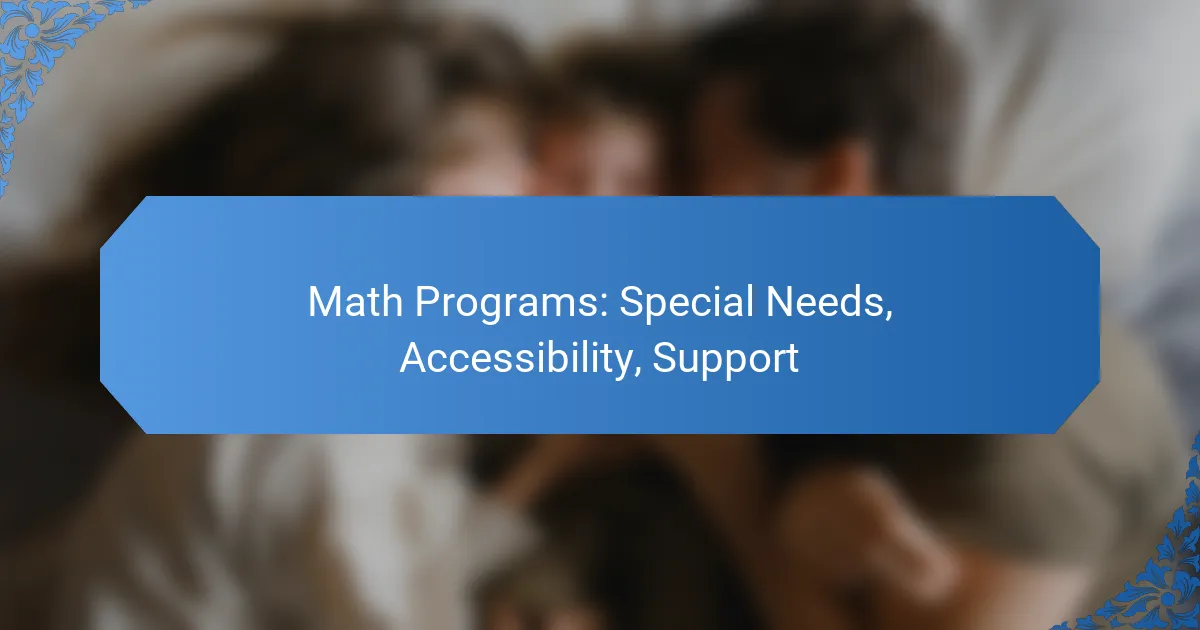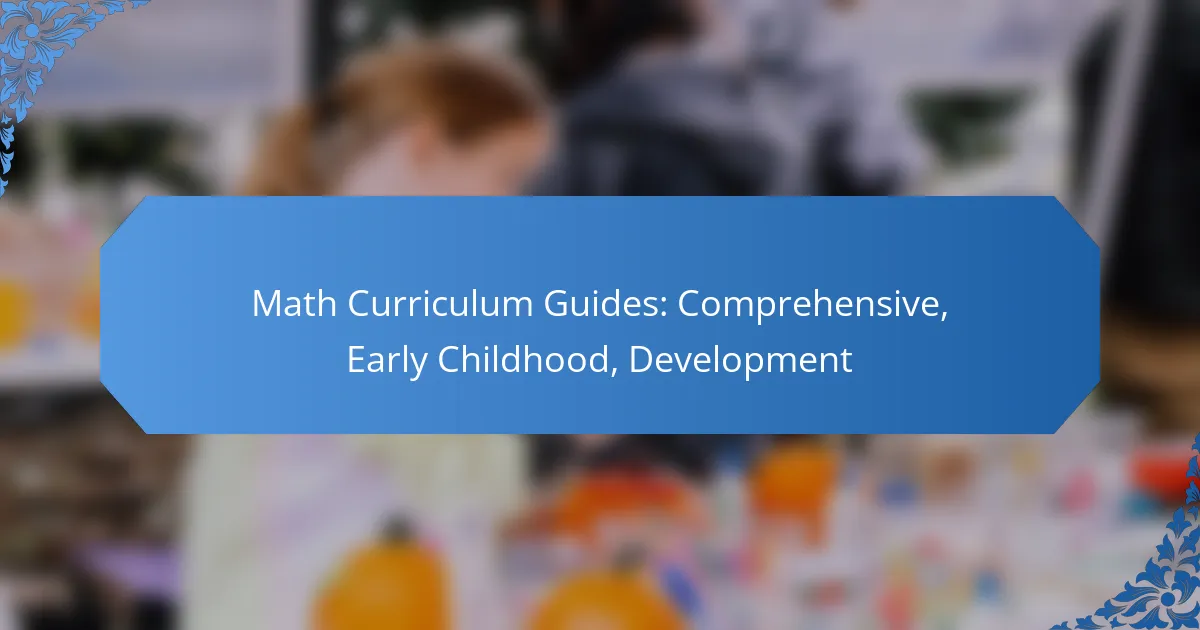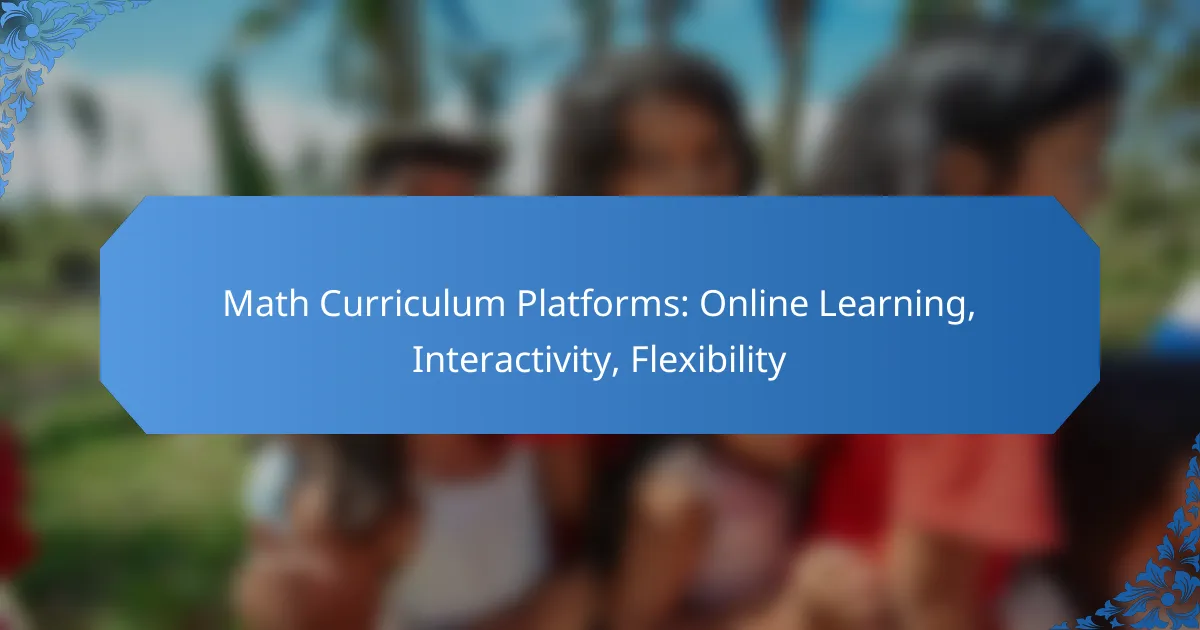Math programs tailored for special needs students focus on accommodating various learning styles and challenges through the use of visual aids, hands-on activities, and interactive elements. By enhancing accessibility with diverse tools and technologies, these programs ensure that all students can effectively engage with the material and achieve their educational goals.

What Are Effective Math Programs for Special Needs?
Effective math programs for special needs students are designed to accommodate diverse learning styles and challenges. These programs often incorporate visual aids, hands-on activities, and interactive elements to enhance understanding and retention.
Math U See
Math U See is a multi-sensory program that emphasizes mastery of concepts through visual aids and manipulatives. It uses a unique approach where students learn math concepts step-by-step, allowing them to build a strong foundation before progressing.
This program is particularly beneficial for students who struggle with abstract concepts, as it provides concrete examples and hands-on activities. Parents and educators appreciate its structured lessons, which can be adapted to individual learning paces.
TouchMath
TouchMath is a tactile learning program that combines visual and auditory elements to teach math. It uses a unique counting system where students touch numbers to reinforce their understanding of basic math operations.
This program is effective for students with learning disabilities, as it engages multiple senses to aid comprehension. TouchMath can be used in various settings, including classrooms and home schooling, making it versatile for different educational environments.
Hands-On Equations
Hands-On Equations is a program designed to teach algebra concepts through physical manipulatives. Students use pieces to represent variables and constants, allowing them to visualize and solve equations.
This approach is particularly useful for students who find traditional algebra challenging. By engaging with physical objects, learners can develop a deeper understanding of algebraic principles in a fun and interactive way.
Mathseeds
Mathseeds is an online program that offers interactive math lessons for young learners, focusing on foundational skills. It uses engaging animations and games to teach concepts such as counting, addition, and subtraction.
This program is suitable for early learners and those with special needs, as it adapts to individual progress. The gamified approach keeps students motivated and encourages regular practice, which is essential for skill retention.
IXL Math
IXL Math is a comprehensive online platform that provides personalized practice in various math topics. It offers immediate feedback and progress tracking, allowing students to work at their own pace.
This program is beneficial for students with special needs as it can be tailored to specific learning goals. The extensive range of topics ensures that learners can reinforce their skills in a structured manner, making it a valuable resource for educators and parents alike.

How Do Online Math Courses Support Accessibility?
Online math courses enhance accessibility by incorporating various tools and technologies that cater to diverse learning needs. These features ensure that students with different abilities can engage with the material effectively and achieve their educational goals.
Adaptive Learning Technologies
Adaptive learning technologies personalize the learning experience by adjusting content and pacing based on individual performance. These systems analyze student interactions and provide tailored resources, ensuring that learners receive support suited to their unique challenges.
For example, platforms may offer additional practice problems for students struggling with specific concepts or advance them to more complex topics when they demonstrate mastery. This flexibility helps maintain engagement and fosters a positive learning environment.
Screen Reader Compatibility
Screen reader compatibility is crucial for visually impaired students, allowing them to access course materials through auditory means. Many online math platforms are designed to work seamlessly with screen readers, ensuring that all text, equations, and graphs are read aloud accurately.
To enhance accessibility, course providers should follow guidelines such as the Web Content Accessibility Guidelines (WCAG), which recommend using clear language and proper formatting. This ensures that screen reader users can navigate content without confusion.
Visual and Auditory Aids
Visual and auditory aids play a significant role in supporting learners with different needs. Online math courses often include videos, interactive simulations, and audio explanations to cater to various learning styles.
For instance, incorporating color-coded graphs can help students visualize data trends, while audio explanations can reinforce understanding of complex concepts. When selecting a course, look for those that offer a variety of multimedia resources to enhance comprehension and retention.

What Criteria Should You Consider When Choosing a Math Program?
When selecting a math program, consider factors such as curriculum alignment, instructor qualifications, and student engagement features. These elements ensure the program meets educational standards, is taught by competent educators, and keeps students actively involved in their learning.
Curriculum Alignment
Curriculum alignment refers to how well a math program matches educational standards and learning objectives. Look for programs that adhere to local or national standards, such as the Common Core in the United States or similar frameworks in other countries. This alignment ensures that the material is relevant and prepares students for assessments.
Additionally, consider whether the program offers differentiated instruction to cater to various learning styles and abilities. Programs that provide tiered lessons or adaptive learning technologies can better support students with special needs.
Instructor Qualifications
The qualifications of instructors play a crucial role in the effectiveness of a math program. Ensure that teachers have relevant credentials, such as degrees in mathematics or education, and experience in teaching diverse learners. Certifications in special education can be particularly beneficial for addressing the needs of students with disabilities.
Moreover, ongoing professional development opportunities for instructors can enhance their teaching strategies and keep them updated on best practices. Programs that prioritize teacher training often yield better student outcomes.
Student Engagement Features
Engagement features in a math program are essential for maintaining student interest and motivation. Look for interactive elements such as gamified learning, real-world applications, and collaborative projects. These features can make math more relatable and enjoyable for students.
Additionally, consider programs that incorporate technology, such as online platforms or apps that allow for personalized learning experiences. Programs that encourage student feedback and participation can also foster a more inclusive and supportive learning environment.
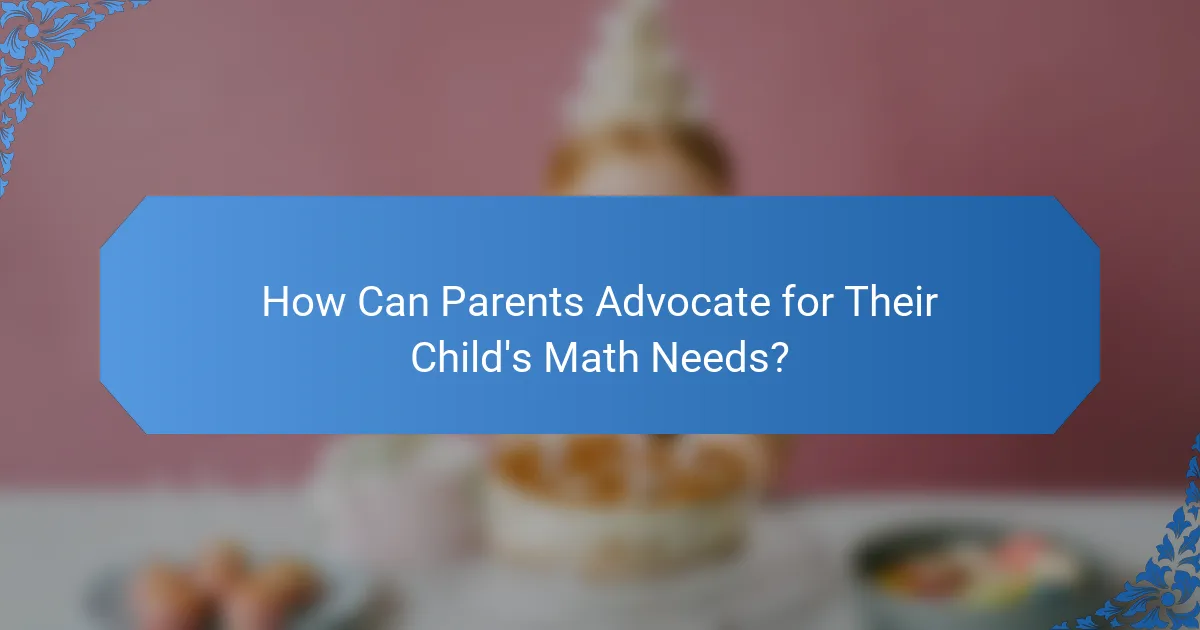
How Can Parents Advocate for Their Child’s Math Needs?
Parents can effectively advocate for their child’s math needs by understanding their rights and actively engaging with educators and support systems. This involves knowing how to navigate Individualized Education Programs (IEPs), maintaining open communication with teachers, and leveraging community resources.
Understanding IEPs
Individualized Education Programs (IEPs) are tailored plans designed to meet the unique educational needs of students with disabilities. Parents should familiarize themselves with the IEP process, including how to request an evaluation and what accommodations may be necessary for their child’s math education.
Key components of an IEP include specific goals, services provided, and methods for measuring progress. Parents should ensure that math-related goals are clearly defined and that appropriate support, such as specialized instruction or assistive technology, is included.
Communicating with Educators
Effective communication with educators is crucial for advocating for a child’s math needs. Parents should schedule regular meetings with teachers to discuss their child’s progress and any challenges they may face in math. Being proactive can help in addressing issues before they escalate.
It’s beneficial to prepare for meetings by gathering relevant data, such as assessment results or examples of work. Parents should express their concerns clearly and collaboratively work with educators to develop strategies that support their child’s learning in math.
Utilizing Community Resources
Community resources can provide additional support for children struggling with math. Local tutoring centers, after-school programs, and online platforms often offer specialized assistance tailored to different learning styles and needs.
Parents should explore options such as special education workshops or parent support groups to connect with others facing similar challenges. These resources can offer valuable insights and strategies for enhancing their child’s math skills.
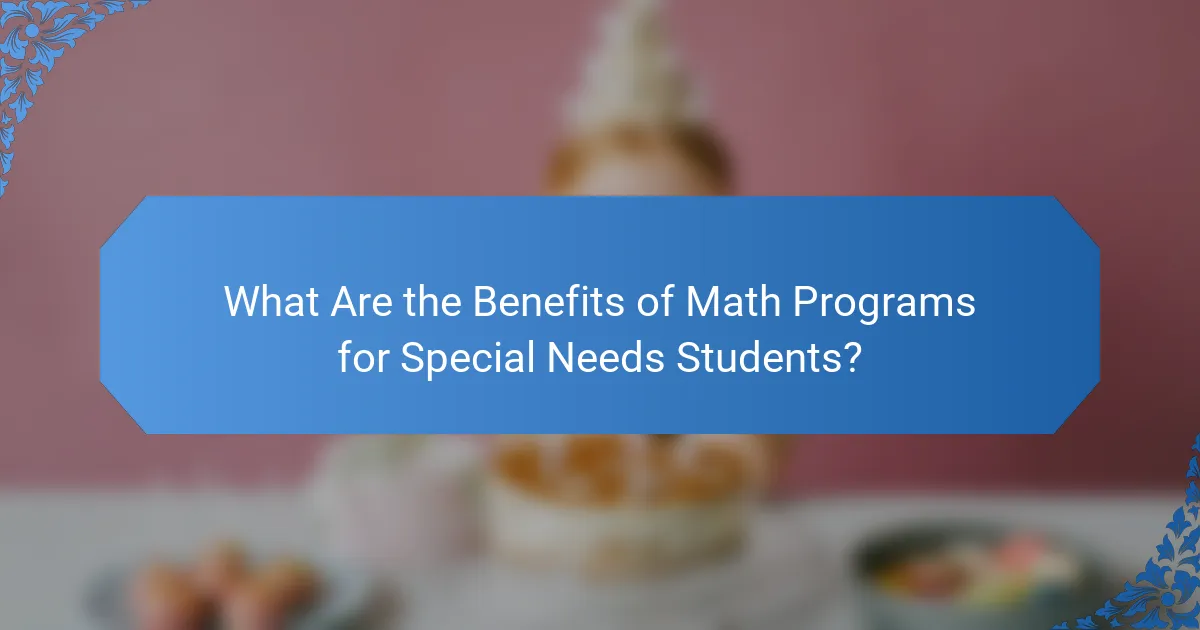
What Are the Benefits of Math Programs for Special Needs Students?
Math programs tailored for special needs students offer numerous advantages, including improved engagement, tailored instruction, and enhanced learning outcomes. These programs are designed to meet diverse learning styles and needs, ensuring that all students can develop their mathematical skills effectively.
Improved Confidence
Special needs students often face challenges that can hinder their confidence in math. Effective math programs provide a supportive environment where students can experience success, which boosts their self-esteem. For instance, using positive reinforcement and celebrating small achievements can significantly enhance their belief in their abilities.
Building confidence can lead to increased participation in class and a willingness to tackle more complex problems. Programs that incorporate collaborative learning also help students feel more secure, as they can share their thoughts and learn from peers.
Personalized Learning Paths
Personalized learning paths are crucial for special needs students, as they allow for individualized pacing and tailored content. These programs often assess each student’s strengths and weaknesses, enabling educators to create customized lessons that address specific challenges. For example, a student struggling with basic addition might focus on foundational skills before progressing to more advanced concepts.
Utilizing technology, such as adaptive learning software, can enhance personalization by adjusting difficulty levels based on student performance. This approach ensures that students remain engaged and can progress at their own pace, which is essential for effective learning.
Enhanced Problem-Solving Skills
Math programs for special needs students often emphasize problem-solving skills, which are vital for real-world applications. By engaging students in hands-on activities and real-life scenarios, these programs help them develop critical thinking abilities. For example, using manipulatives or visual aids can make abstract concepts more concrete and relatable.
Encouraging students to approach problems from different angles fosters creativity and resilience. Programs that incorporate group work or peer tutoring can further enhance these skills, as students learn to collaborate and share strategies with one another.
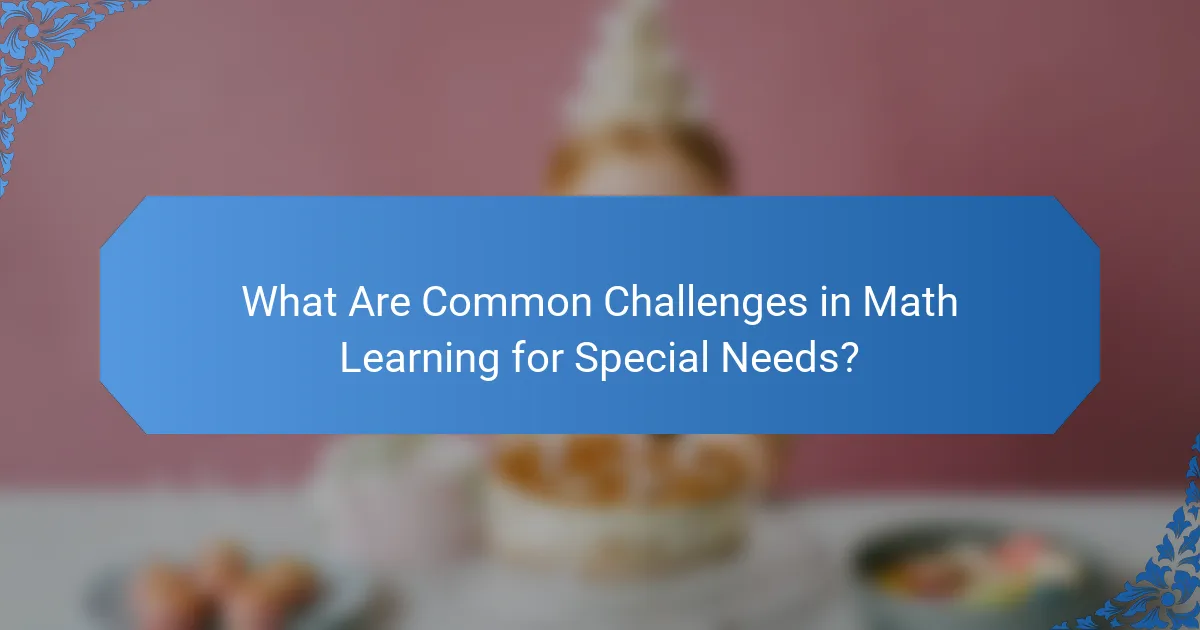
What Are Common Challenges in Math Learning for Special Needs?
Students with special needs often face unique challenges in math learning, including difficulties with processing information, understanding abstract concepts, and maintaining focus. These obstacles can hinder their ability to grasp foundational math skills, leading to frustration and disengagement.
Processing Difficulties
Processing difficulties can manifest as challenges in understanding instructions, following multi-step problems, or retaining information. Students may struggle to translate verbal or written prompts into actionable steps, which is crucial in math. For instance, a student might find it hard to remember the order of operations when solving equations.
To support these learners, educators can break down tasks into smaller, manageable parts and use visual aids. Techniques such as color-coding steps or using graphic organizers can enhance comprehension and retention.
Abstract Concept Understanding
Many students with special needs have trouble grasping abstract mathematical concepts, such as fractions or algebra. These concepts often require a level of cognitive flexibility that some learners may not possess. For example, a student might struggle to understand that 1/2 is equivalent to 2/4 without concrete examples.
Using hands-on materials, like fraction tiles or number lines, can help bridge the gap between concrete and abstract thinking. Incorporating real-life scenarios, such as cooking or shopping, can also make these concepts more relatable and easier to understand.
Focus and Attention Issues
Focus and attention issues can significantly impact a student’s ability to engage with math tasks. Students may find it difficult to concentrate for extended periods, leading to incomplete assignments or errors. This can be particularly challenging in a traditional classroom setting where distractions are prevalent.
To address these challenges, educators can implement strategies such as providing frequent breaks, using timers to create a sense of urgency, and allowing for flexible seating arrangements. Incorporating technology, like math apps that gamify learning, can also help maintain interest and focus.
